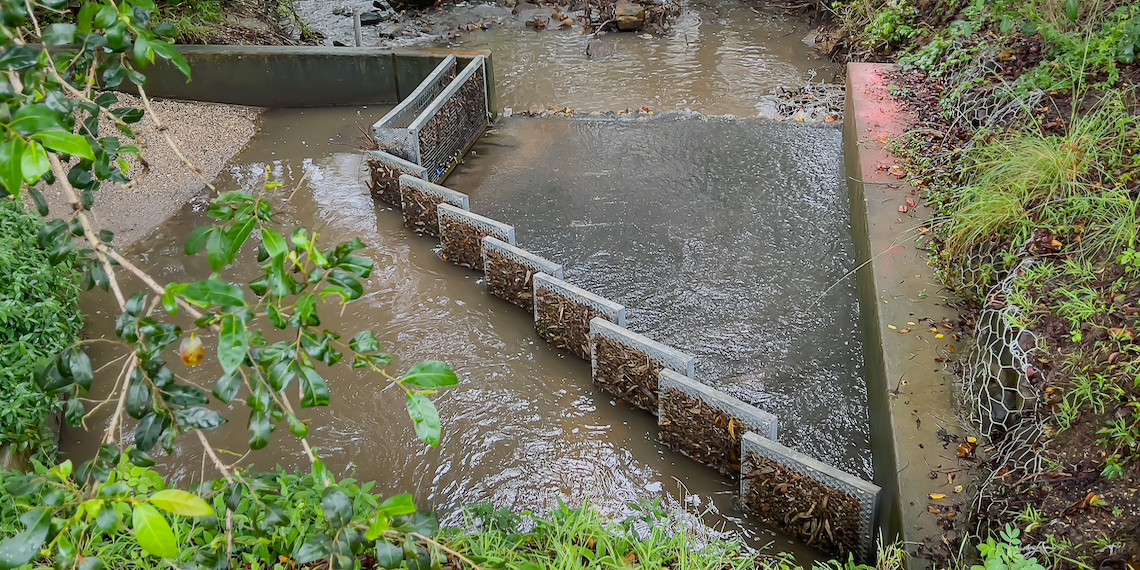Why stormwater management should start in the catchment

Stormwater management has gained a lot of exposure in the urban context – including treatment, harvesting and reuse opportunities – but one leading water management expert says that working within the larger non-urban catchment can deliver huge offsetting benefits that may be of greater value.
Water Technology Director Tony McAlister said taking nature-based, whole-of-catchment approaches to stormwater management not only costs less than many urban water management solutions, but also provides a wide range of associated benefits from working with the environment.
“From an urban perspective, water quality is a major consideration of stormwater and wastewater management planning. Urban stormwater contains high levels of nutrients and pathogens, and it can contain a hell of a lot of sediment. And most wastewater plants in Southeast Queensland are reaching the point of diminishing return when it comes to treatment,” he said.
“At a whole of catchment level, we’ve been doing plenty of work recently that involves getting up into the catchment and using nature-based solutions to offset otherwise difficult or expensive downstream urban stormwater and wastewater treatment.
“Treating urban stormwater and wastewater can be very expensive. If we take that money and apply it to nature-based solutions in the upper catchment, it can make a massive difference.”
McAlister said considering stormwater management through a catchment lens also produces more sustainable outcomes, as nature-based solutions work with the environment to produce a breadth of knock-on benefits.
“By working within the catchment, you get multiple benefits – not only does this approach avoid expensive stormwater and wastewater treatment, it also supports the health of habitat, mitigates the impact of flooding, and increases land amenity,” he said.
There is a lot of momentum within the water community for sustainable and energy-efficient solutions, particularly with potential net zero discharge targets being set for sensitive catchments and waterways, McAlister said, and managing stormwater should be no different.
“The only way we can achieve net zero holistically is via the implementation of integrated water management solutions. With nature-based stormwater management, we can remove and mitigate materials from the upper catchment to then lessen or offset downstream treatment requirements and ensure the environment is protected,” he said.
While starting management in the catchment is key to achieving more sustainable stormwater strategies, McAlister said it is also crucial that the receiving environment is kept front of mind when planning and implementing solutions.
“It’s important to understand the unique characteristics of every receiving environment. This should be the primary influence in stormwater management planning. Unfortunately, a lot of state-based urban stormwater quality policies are very formulaic,” he said.
“If we want to work more with the environment, then we should be assessing the nature of each receiving environment and tailoring our solution appropriately. Of course, requirements will differ depending on the location and we need to start tailoring our stormwater management solutions to those requirements.”
Working with the environment
In recent years, the Queensland Government has introduced a nutrient offset policy that is being embraced widely by water authorities, McAlister said, with the benefits to be gained from catchment management front of mind.
“Everyone is realising that they can get greater benefits by investing in catchment and nature-based stormwater management projects, at a much lower price, rather than spending more and more on urban stormwater management and end of line wastewater treatment and disposal,” he said.
“We are currently designing wetlands on one particular floodplain to help clean and treat stormwater. And we are also designing a system that reengages about 35 hectares of mangroves, including re-vegetation. Both of these will offset wastewater treatment and disposal requirements.
“Not only do these works mitigate stormwater and wastewater issues, the mangroves will also sequester massive amounts of carbon. Once we start working with the environment, both pre- and post-treatment, we create sustainability benefits – it’s really that simple.”
McAlister said one of the hurdles the water sector faces in moving toward more nature-based stormwater management solutions is old-school inertia.
“Organisations of all types get swept towards expensive, big-infrastructure solutions because that’s how things have always been done,” he said.
“But with a bit of leadership in the integrated water management solutions space, and the willingness to trust that nature-based solutions work, we can head to a much more sustainable way of dealing with these issues.”
Nature-based offsets
McAlister said there are plenty of examples of nature-based solutions that showcase how working with the environment can lead to broader benefits, like flood management.
“If a large section of a waterway is heavily eroded, we can stabilise the banks and riparian zone by structural works and, importantly, planting a lot of trees,” he said.
“Not only does this reduce stream bank-derived sediment loads, it also slows down flood velocities. And when you slow the flood velocity, there isn’t as much scour of nutrient rich sediment from adjacent farming properties.
“Flood level peaks are also lower and take longer to get downstream, meaning that communities have more time to prepare for damaging flood events.
“It really is astonishing to see how many of the water sector's major concerns are alleviated by working first in catchment.”
Water Technology is currently working as part of a Griffith University lead team on the Building Catchment Resilience project, funded by the Ian Potter Foundation, which is developing an innovative modelling and visualisation tool to help plan the most effective in-catchment water management strategies.
“It’s about building a next-generation modelling and management assessment tool to enable a deeper understanding of the best places to intervene at a catchment level to achieve certain performance objectives,” he said.
“It’s still a work in progress, but I do believe that this type of tool will be a real game changer – it will be a catalyst for a more sustainable way of going about how we manage stormwater, as well as a range of other interconnected issues relating to the water cycle.”
